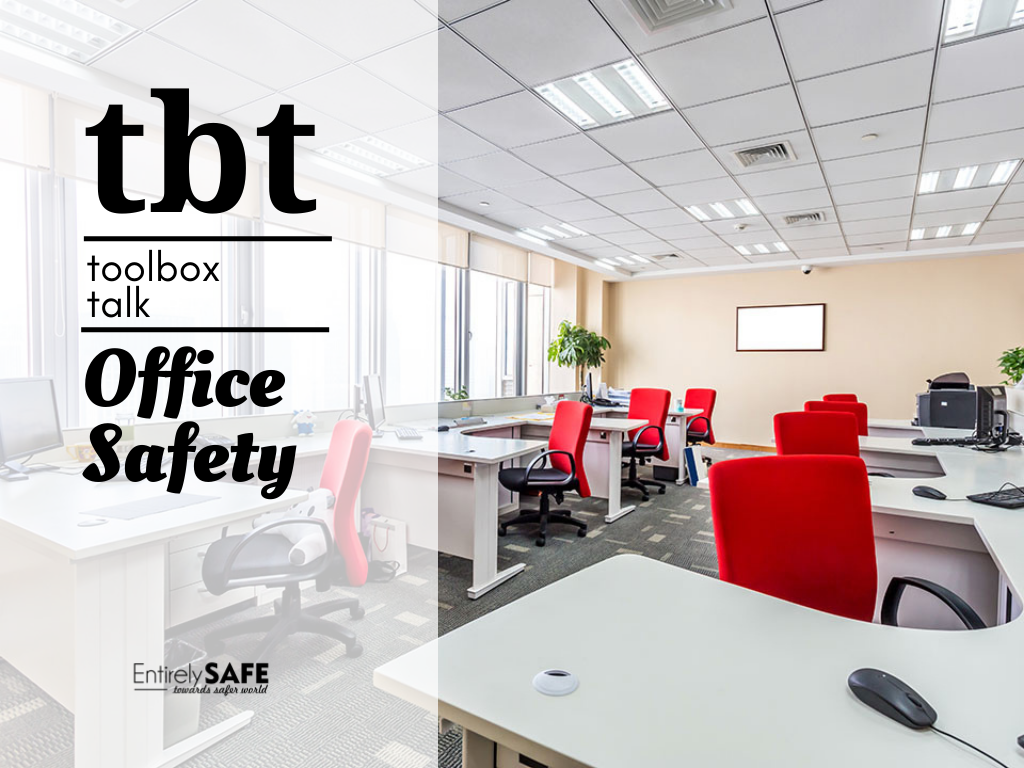Working Safely in the Office Toolbox Talk

Before the Toolbox Talk
This safety talk is designed for discussion leaders to use in preparing safety meetings. Set a specific time and date for your safety meeting. Publicize your meeting so everyone involved will be sure to attend. Review this safety talk before the meeting and become familiar with its content.
Make notes about the points made in this talk that pertain to your workplace. You should be able to present the material in your own words and lead the discussion without reading it.
Seating space is not absolutely necessary, but arrangements should be made so that those attending can easily see and hear the presentation. Collect whatever materials and props you will need ahead of time. Try to use equipment in your workplace to demonstrate your points.
Give the safety talk in your own words. Use the printed talk merely as a guide. The purpose of a safety meeting is to initiate a discussion of safety problems and provide solutions to those problems. Encourage employees to discuss hazards or potential hazards they encounter on the job. Ask them to suggest ways to improve safety in their area. Don’t let the meeting turn into a gripe session about unrelated topics. As a discussion leader, it’s your job to make sure the topic is safe. Discussing other topics wastes time and can ruin the effectiveness of your safety meeting.

Toolbox Talk: Working Safely in the Office
Despite claims that offices are relatively free of hazards, injuries still occur. These injuries are generally different from those sustained in manufacturing, construction, and other businesses, but the results are the same. Office accidents can be put into six different categories–slipping, tripping, and falling; improperly used or faulty equipment; collisions or obstructions; falling objects; fire and electricity; and horseplay and accidents that do not fit into other categories. Each year the greatest number of injuries is in the slips, trips, and falls category.
Recently in Ohio, the number totaled 64 percent of all office injuries. Most of these injuries could have been prevented with a little extra effort. For example, floors, including storage spaces, should be clean, well-lighted, dry, and free of debris that could cause a fall. Spills should be cleaned up immediately, and when bad weather occurs, slip-resistant mats should be placed in building entrances. Make sure stairways have anti-slip treads and handrails. Report any potential hazards to your supervisor or fix them yourself, if possible.
Damaged floor surfaces–splintered wood, broken tile, or pitted concrete—should be repaired or replaced as soon as possible. Highly polished surfaces, like linoleum or tile, should be coated with a slip-resistant finish. Carpet can also cause some problems if it is allowed to deteriorate. Rugs and carpets should be secured to prevent trips and falls. If office manuals and supplies are stored on shelves that cannot be reached without mechanical aid, use a ladder, not a chair or other piece of office furniture. To prevent accidents and injuries caused by obstructions, plan the layout of workspaces carefully.
Desks and file cabinets, for instance, should be arranged so that the drawers do not open into aisles or walkways. And close drawers as soon as you’ve found what you were looking for. This may prevent someone from tripping over them or banging a shin against them. Materials should not be stored in corridors or other traffic areas. Besides being traffic hazards, these materials may fall over if they are improperly stacked. Telephone, typewriter, and other electrical equipment cords are obvious tripping hazards.
Arrange the furniture so that it covers the cords or tape cords to the desks or the floor. If there are differences in floor elevations in the building, railings and warning signs should be provided. Office machinery and equipment can be hazardous if it is used for other than its intended purpose or if it is not properly maintained. If you work with office machines, make sure you know how to operate them properly. If you’re unfamiliar with the equipment, check with your supervisor. Electrical equipment, like copiers, typewriters, dictaphones, pencil sharpeners, space heaters, and coffee makers, should be in good repair and grounded where required. Coffee makers and smaller appliances should be unplugged before you go home.
Even something as simple as a pen or pencil can be hazardous for office workers. They should be stored with their points down.
Letter openers, scissors, and razor blades should be sheathed or placed out of the way when not in use. Thumbtacks and paper clips should be stored in separate containers to prevent cuts and puncture wounds. Use caution when using a paper cutter–it has no way of differentiating between paper and flesh. After you’re finished with it, store the paper cutter with the blade locked down.
Other seemingly minor hazards can be serious. Rough edges or burs on furniture may cut fingers and snag clothing, so it’s a good idea to file them down. Chipped or broken office furniture should be replaced or repaired. Notify your supervisor if you discover items in need of repair. If you have to dispose of broken glass, pick it up with several thicknesses of wet paper towels. Make sure the housekeeping crew knows it’s in the trash.
Fire is also a hazard in offices, but there are things you can do to prevent fires. Office equipment should be properly grounded when required and electrical connections should be checked periodically for frayed or damaged cords. Be prepared by knowing where the fire extinguishers are, how to decide which one is called for, and how to use it. Fire extinguishers should be inspected monthly by a designated employee.
Flammable liquids should be stored in locked, approved storage cabinets in the office. Large quantities should not be stored in the office. Be careful not to dump hot ashes from ashtrays into wastebaskets. Office-worker traffic patterns may be responsible for some collisions. Two-way traffic around blind corners shouldn’t be a problem–just walk to the right and slow down at intersections.
If you’re carrying material, make sure you can see over the load. nd watch where you’re going. Don’t walk backward and hold a conversation to a minimum; concentrate on reaching your destination with your load intact.
Look for obstacles in your path–a pencil sharpener extending beyond the edge of a desk, an open drawer, a misplaced briefcase, or a trash can. Some offices have more window area than others. Make sure you don’t try to walk through a window or glass door. Most of them are marked. If you see one that is not, let your supervisor know. Unlettered glass surfaces should have a stencil or decal approximately 4 1/2 feet above the floor.
Partly opened doors should be approached with caution. The person coming through may be unaware of your presence. Watch for overhead hazards also. Never store heavy materials, like card files, on top of the cabinets. Movable objects, such as flower pots, vases, and boxes, should not be placed on window sills or ledges. Ceiling fixtures and fans should be inspected regularly to make sure they are secure and to ensure their safe operation. Pulley cords on Venetian blinds and operating mechanisms for windows should also be checked. Proper placement of materials in file cabinets is an effective safety measure.
Cabinets that have more weight in the top drawers may tip over when the drawer is opened. If it is not possible to distribute the weight in the cabinet, fasten it to the wall or another cabinet or add weight to the bottom of the cabinet. Many of the accidents and injuries that occur can be placed into one of the five major classifications. But some do not seem to œit the said categories. Tilting back on chairs with rollers, for example, can produce a serious injury. And so can using that same chair as a ladder.
Staplers can be hazardous if used improperly. Even paper can produce painful cuts. These cuts can be prevented by allowing more room for files in the file cabinet. Back injuries occur frequently–to avoid them, limit material handling to stable, moderate loads held close to the body at all times. Try to restrict material handling to the area between the knuckle and shoulder height.
Interactive Discussion
- Have you or someone you know been injured or nearly injured while carrying out this activity? What happened?
- How can we stay safe today?
- What do we do at the worksite to prevent injuries related to this activity?
After the Toolbox Talk
At the end of the meeting, ask employees to sign a sheet on the back of this talk as a record that they attended the safety meeting. Keep this talk on file for your records.

